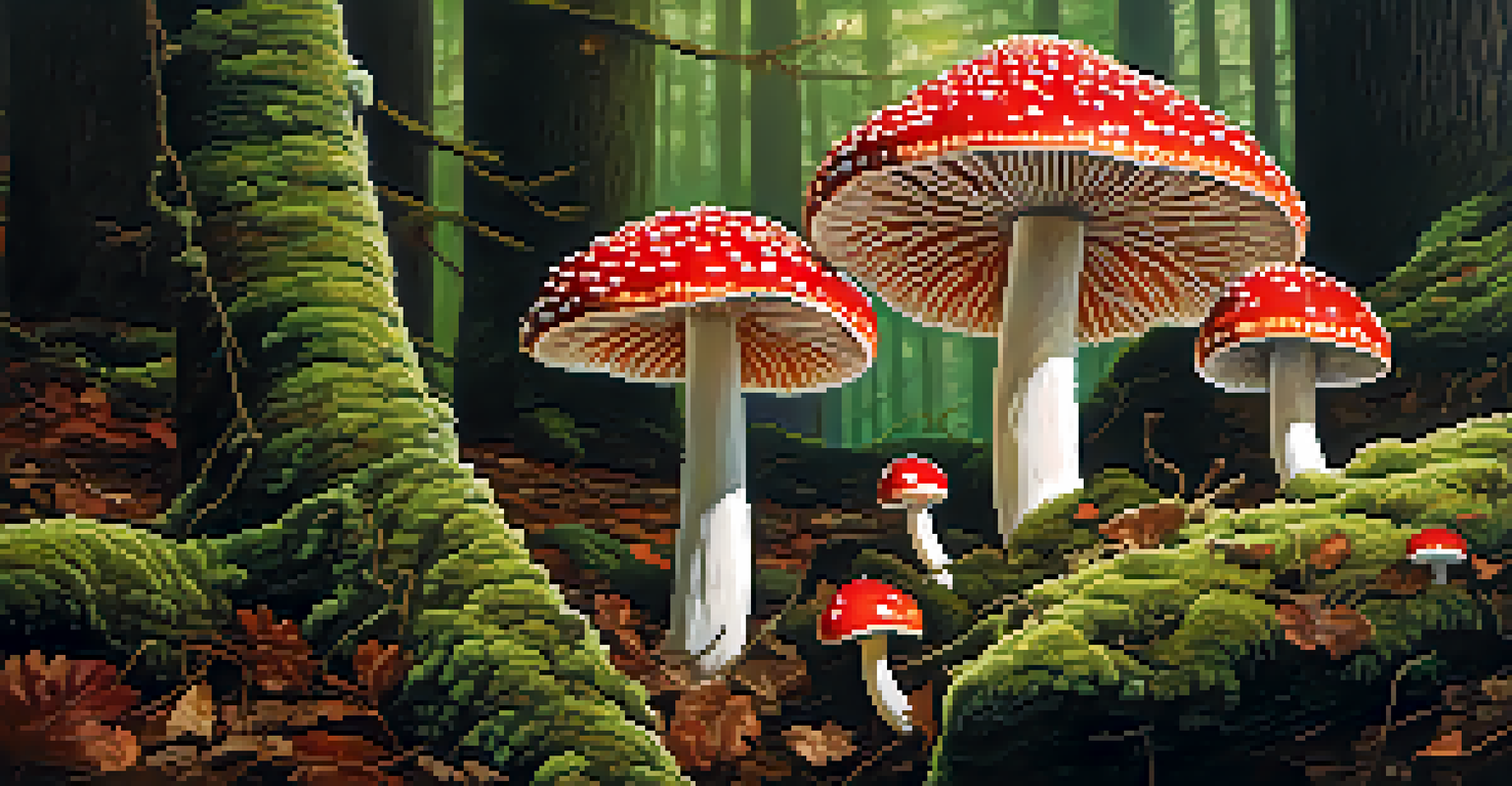Perspectives on Hallucinogens in Asian Cultures and Religions

Historical Context of Hallucinogens in Asia
Hallucinogens have been part of Asian cultures for centuries, often intertwined with spiritual practices. Ancient texts and archaeological findings suggest that various plants and fungi have been used in rituals and healing. For instance, the Vedic texts of India reference the use of Soma, a sacred drink believed to induce altered states of consciousness.
The use of psychedelics can facilitate profound personal transformation and healing.
These substances were not merely for recreation; they served a higher purpose in seeking enlightenment or connecting with the divine. Many cultures viewed these experiences as a way to transcend the ordinary and access deeper truths about existence. This historical context highlights the reverence with which these substances were regarded.
Understanding the historical significance allows us to see how hallucinogens shaped social and religious practices. They were seen as tools for transformation, both personal and communal, influencing art, philosophy, and spirituality. As we explore further, we’ll uncover how these perceptions have evolved over time.
Hallucinogens in Hinduism and Buddhism
In Hinduism, substances like cannabis and certain mushrooms have been used in rituals to enhance spiritual experiences. These practices are often linked to achieving higher states of consciousness and connecting with deities. For example, the use of bhang during festivals like Holi is not just celebratory but also carries spiritual significance.

Buddhism, on the other hand, takes a more cautious approach to hallucinogens. Traditional teachings emphasize mindfulness and meditation as pathways to enlightenment rather than relying on external substances. However, some sects have explored the use of psychedelics for deepening meditation practices, creating a fascinating dialogue between traditional beliefs and modern interpretations.
Hallucinogens in Asian Spirituality
Hallucinogens have been historically integrated into Asian spiritual practices, serving as tools for enlightenment and community healing.
Both religions illustrate a spectrum of attitudes towards hallucinogens, where one embraces their use, while the other prioritizes mental discipline. This dichotomy highlights the diversity within Asian spiritual practices and invites us to consider how these substances may serve different roles in various contexts.
Shamanic Traditions and Plant Medicine
Shamanic practices in various Asian cultures often involve the use of hallucinogenic plants for healing and divination. For instance, in Siberian shamanism, the Amanita muscaria mushroom is used to induce trance states that facilitate communication with spirits. These experiences are viewed as essential for community healing and guidance.
Understanding the cultural roots before engaging with these practices is essential to honor their significance.
Similarly, in South Asia, the use of ayahuasca among indigenous tribes has garnered attention for its therapeutic properties. While rooted in tradition, these practices have gained recognition in modern wellness circles, highlighting a blend of ancient knowledge and contemporary health paradigms. This cross-cultural exchange emphasizes the timeless appeal of plant medicine.
These shamanic traditions illustrate the powerful connection between nature and spirituality in Asian cultures. By exploring these practices, we can appreciate how hallucinogens are woven into the fabric of community life and individual healing, providing insights into the human experience.
Contemporary Views on Hallucinogens in Asia
In recent years, there has been a resurgence of interest in hallucinogens across Asia, particularly in the context of mental health and wellness. Countries like Japan and India are witnessing a growing acceptance of psychedelics as therapeutic tools, often rooted in traditional practices. This shift reflects a broader global trend towards re-evaluating the role of these substances.
However, the legal and social landscapes surrounding hallucinogens vary widely across Asian nations. While some countries are exploring decriminalization and research opportunities, others maintain strict prohibitions based on historical and cultural stigmas. This disparity creates a complex dialogue about the future of hallucinogens in Asian societies.
Modern Therapeutic Interest
Recent research and changing attitudes towards hallucinogens in Asia highlight their potential therapeutic benefits, particularly for mental health.
As contemporary views evolve, they challenge long-held beliefs and invite discussions about the intersections of culture, spirituality, and science. This ongoing conversation is crucial as it shapes the future landscape of hallucinogens in Asia, blending ancient wisdom with modern understanding.
Psychedelic Research and Its Implications
Scientific research into hallucinogens has gained momentum, revealing potential benefits for mental health conditions such as PTSD and depression. Asian countries are increasingly participating in this research, contributing rich cultural insights that enhance our understanding of these substances. Studies are often framed within traditional contexts, merging modern science with ancient practices.
These findings challenge the stigma surrounding hallucinogens and open the door for therapeutic applications. As researchers delve into the psychological and neurological effects, they are uncovering how these substances can facilitate profound personal transformation and healing. The implications are vast, affecting policy decisions and societal attitudes towards mental health treatment.
This intersection of research and culture emphasizes the need for a nuanced approach to hallucinogens. By respecting traditional practices while embracing scientific inquiry, we can foster a more comprehensive understanding of their potential benefits and risks.
Cultural Misunderstandings and Appropriation
As interest in hallucinogens grows globally, cultural misunderstandings and appropriation can arise, particularly in the context of Asian practices. Western fascination with Eastern spirituality often oversimplifies complex traditions, leading to misrepresentation. This can dilute the rich cultural heritage associated with these substances, reducing them to mere trends.
Moreover, the commercialization of hallucinogens can undermine their sacred significance within their original cultures. When practices are stripped of their context and sold as wellness fads, it raises ethical questions about respect and authenticity. This highlights the importance of understanding the cultural roots before engaging with these practices.
Cultural Sensitivity and Respect
The growing global interest in hallucinogens necessitates a careful understanding of their cultural significance to avoid appropriation and misrepresentation.
Addressing these issues requires awareness and sensitivity to the historical and cultural significance of hallucinogens. By fostering respectful dialogue and education, we can honor these traditions while promoting responsible use and understanding of their role in various cultures.
The Future of Hallucinogens in Asian Cultures
Looking ahead, the future of hallucinogens in Asian cultures is poised for evolution, influenced by both traditional practices and modern scientific advancements. As societies grapple with mental health crises, there is a potential for renewed interest in the therapeutic uses of these substances. This could lead to a re-examination of age-old beliefs in light of contemporary needs.
Furthermore, the growing global dialogue about psychedelics can foster cross-cultural exchanges that enrich understandings of these substances. Collaborative research and respectful sharing of knowledge can create a more informed perspective on their potential roles in culture and medicine. This integration could pave the way for innovative approaches to mental health and spiritual wellness.

Ultimately, the future hinges on a balanced approach that honors both tradition and progress. By embracing this duality, Asian cultures can navigate the complexities of hallucinogens, ensuring they are respected as tools for healing and enlightenment in a rapidly changing world.